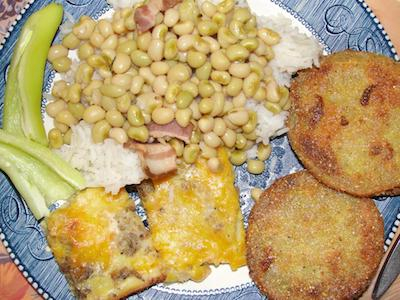
Southern peas are both delicious and nutritious.
May 9, 2023 - It’s finally warm enough to plant peas. When you say “pea” to most gardeners in the world, they think of green “English” peas that thrive in cool moist environments. But to most Southerners, a hot weather legume from Africa, more related to beans, is the norm. Despite what Northerners say about our peas being “cattle food,” many of our ancestors dined on them practically daily throughout their lives. They are easy to grow, very productive, and very nutritious, being high in both fiber and protein. Southern peas come in many varieties and colors including both standard types and those fat ones crowded into their pods known as “crowders.” I never met any Southern pea I didn’t like. You can get peas dried or canned, but no pea holds a candle to fresh ones picked from your own garden.
Southern peas are a warm season crop that cannot tolerate frosts or freezes. As matter of fact, they can’t even stand cool days or nights. They thrive on heat, so should be planted well after the last frost. This is generally mid-April or later in East Texas. They can be planted anytime up until July 4th, which means two crops can be produced each year. Southern peas are easily planted from seed. Once the seedlings are established and about 3-4 inches tall, thin them to 6-8 inches apart.
Southern peas require at least 8 hours of direct sun each day (full sun). They aren’t terribly picky about soil types but should be planted in areas that drain well. It is ideal to till in several inches of compost or organic matter into the soil if possible and incorporate 1 pound of a complete garden fertilizer (13-13-13, 10-20-10, etc.) per 100 square foot of bed or every 35 feet of row. They do not require sidedressing with additional nitrogen fertilizer like most other crops. The ideal soil pH for growing Southern peas is 6.0-7.0.
Create a raised row about 4-6 inches high and 16-24 inches wide. Multiple rows should be around 36 inches apart. Open a shallow trench 1 ½ inches deep with the corner of a hoe or a stick. Drop the seed several inches apart to insure a good stand. Cover lightly with loose soil using a hoe or garden rake. Unfortunately, it takes a decent sized block or row of peas to produce enough to eat, so they aren’t adapted to container culture or small raised beds.
Southern peas are easy to grow and fairly drought tolerant. My most frequent problem is aphids which can be controlled with an appropriately labeled organic insecticide.
Depending on the variety, Southern peas are generally ready to pick 70-90 days from planting the seed. Pick fresh peas when the pods become yellowish, reddish, or purple, depending on the variety and when the peas are plump inside. Be sure and pick them before they turn brown and dry out. The peas should pop out easily when you press on the pod seam with your thumb. Peas picked too green are much more difficult if not impossible to shell. Small, thin, undeveloped pea pods are sometimes picked and cooked as “snaps” with the shelled peas. It’s easy to save your own pea seed for next year by picking, shelling, and saving the dried peas and storing in the freezer.
Recommended Southern pea varieties for Texas include Black Crowder (crowder), California #5 (black-eye), Cream #40 (cream), Mississippi Silver Skin (crowder), Pink Eye Purple Hull (purple hull), Zipper Cream (cream, crowder), and many more. Black-eyed peas, cow peas, crowder peas, and field peas are all different names referring to our Southern peas which are native to Africa and should be a staple on every East Texas table.
Greg Grant is the Smith County horticulturist for the Texas A&M AgriLife Extension Service. He is the author of Texas Fruit and Vegetable Gardening, Heirloom Gardening in the South, and The Rose Rustlers. You can read his “Greg’s Ramblings” blog at arborgate.com and read his “In Greg’s Garden” in each issue of Texas Gardener magazine (texasgardener.com). More science-based lawn and gardening information from the Texas A&M AgriLife Extension Service can be found at aggieturf.tamu.edu and aggie-horticulture.tamu.edu.








